Multitargeting Pesticides
Special Issues
The usefulness of liquid chromatography–mass spectrometry–mass spectrometry (LC–MS-MS) methods for the unambiguous identification and quantification of pesticides in complex matrix samples is well known. Triple-quadrupole systems have proven to be useful for this task because of their high specificity in MS-MS mode and their low detection limits. However, working in MS-MS mode makes any MS system blind to other compounds of interest.
The usefulness of liquid chromatography–mass spectrometry–mass spectrometry (LC–MS-MS) methods for the unambiguous identification and quantification of pesticides in complex matrix samples is well known. Triple-quadrupole systems have proven to be useful for this task because of their high specificity in MS-MS mode and their low detection limits. However, working in MS-MS mode makes any MS system blind to other compounds of interest.
Therefore, it is difficult to develop methods for simultaneous analysis of high numbers of pesticides. Thus, other ways of achieving specificity are of interest, such as the high mass accuracy and mass resolution of an electrospray ionization time-of-flight (ESI-TOF) system. It can generate high specificity without limiting the number of simultaneously observed target compounds (that is, multitargeting) (1,2).
Molecular Formula Generation: The Isotopic Pattern Filter
With high mass accuracy alone, confident molecular formulas cannot be generated for the most part. An isotopic abundance pattern filter must be applied to reduce the number of molecular formula candidates if, for example, the presence of a putative compound must be confirmed (3).
Using a modern ESI-TOF MS system and a sophisticated software solution, ESI-TOF MS is a key to both simultaneous screening for multiple targets and sum formula confirmation. This is because the mass accuracy is apparently independent of peak intensity, so it is possible to generate extracted ion traces with a window down to a few millidaltons, allowing for extreme selectivity and simple and fast identification.
Additionally, the conserved correct isotopic pattern makes it possible to reduce the number of possible hits within a given mass interval by at least one order of magnitude. Isotopic analysis software strongly helps to find the correct elemental composition (Figure 1). For a similar confidence with mass accuracy alone, 50 ppb would be required, based upon the unambiguous formula generation from reserpine, a 609-Da molecule.
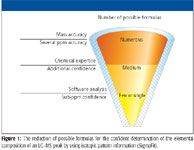
Figure 1
Experimental
Different matrix samples, spiked at various levels with a commercial pesticide standard (Pesticide Mix 34, Ehrenstorfer, Augsburg, Germany), were analyzed using an Agilent 1100 LC system (Agilent Technologies, Waldbronn, Germany) interfaced with a micrOTOF ESI-TOF mass spectrometer. A 125 mm × 2.1 mm, 3-μm Hypersil ODS C18 reversed-phase high performance liquid chromatography (HPLC) column with an acetonitrile–water (1 mM ammonium acetate) gradient (5–55% acetonitrile in 45 min with a 0.2-mL/min flow rate) was applied for separation.
The MS system was equipped with an orthogonal ESI source and was operated in positive mode. Calibration was performed externally with a sodium formate solution before analysis of a sample series, and internally in addition, for each chromatogram by injecting the calibrant at the beginning and at the end of each run via a six-port divert valve equipped with a 100-μL loop. SigmaFit software (Bruker) was used for isotope analysis.
Selective Recovery of Three Pesticide Isoforms From a Plant Extract
The selectivity of the method based on accurate mass traces is demonstrated for three azine isoforms spiked in chamomile (Figure 2). A window of 10 mDa gives a dozen peaks, whereas a selectivity of a mass trace defined to a window of 3 mDa is sufficient for unequivocal identification. Retention time is required for the attribution of the individual isomers.
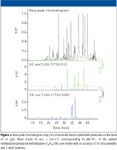
Figure 2
Detection limits well below 2 ppb have been determined, both for standards (Figure 3) and for spiking this amount in various matrices (Figure 4 for lettuce extract).
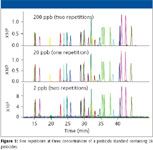
Figure 3
A basic requirement for reliable detection of compounds with such narrow mass traces is the mass stability for a wide dynamic range over the entire peak. As Figure 3 shows, this mass stability is given for at least four orders of magnitude.
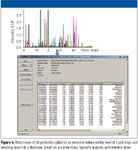
Figure 4
Multitarget Compound Analysis of Pesticides
Automated target detection for the pesticide standard mix spiked to a lettuce extract can be achieved by automated peak detection on the extracted ion chromatograms (EICs) expected for the [M+H]+ ions of each compound in a database. This database contains the names, sum formulas, exact masses, and retention times for about 230 pesticides.
As shown previously, a mass window of 3 mDa allows for selective detection of the compounds, if present. Based upon accurate mass and known retention times, the compounds present in the sample are identified. For each identification candidate, the theoretical isotope abundance pattern is compared with the experimental one. The derived SigmaFit values serve either for confirmation of the putative compounds or to prevent false positive identifications by combination of accurate mass with the true isotopic pattern for the highest confidence in compound identification. Figure 4 shows the EICs and database search results for the spiked lettuce extract.
Conclusion
Screening of several hundred possible pesticides is easily feasible with one single ESI-TOF MS run. Based upon accurate mass, a high selectivity is achieved. Even over a dynamic range of four orders of magnitude, the mass traces could be defined within 0.003 Da. With sensitivity in the sub-part-per-million-range, pesticides can be characterized readily on the level of policy requirements in a variety of matrices.
Efficient multitarget screening using this system also was reported elsewhere: Toxicological drug screening in urine was based upon accurate mass, isotopic pattern analysis, and automated database search. In automatic runs, correct SigmaFit values and accurate masses were achieved over a wide dynamic range, while a mean mass error was only 2.51 ppm (4).
Compared with classical approaches by triple-quadrupole instruments, an ESI-TOF MS approach allows a high number of targets to be screened within one LC run and without the loss of sensitivity; it allows identification of unknown peaks based upon accurate mass and isotopic pattern information from the software, while data can be archived and reprocessed later for additional compounds. Moreover, data can be profiled for further statistical evaluation.
Petra Decker is an application scientist at Bruker Daltonics (Bremen, Germany) with focus on electrospray applications. Matthias Pelzing is applications manager for Bruker Daltonics Pty. (Melbourne, Australia). Christian Neusuess was an application scientist for Bruker Daltonics (Bremen, Germany) and is now professor of analytical chemistry at the University of Applied Sciences in Aalen, Germany. Ralf Ketterlinus is marketing communications manager at Bruker Daltonics (Bremen, Germany). He graduated at the University of Hamburg in molecular biology.
References
(1) H. Sasaki, J. Yonekubo, and K. Hayakawa, Anal Sci. 22(6), 835–840 (2006).
(2) S. Lacorte and A.R. Fernandez-Alba, Mass Spectrom Rev. 25(6), 866–880 (2006).
(3) T. Kind and O. Fiehn, BMC Bioinformatics, 7, 234 (2006).
(4) S. Ojanperä et al., RCM 20, 1161–1167 (2006).
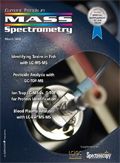
Trending on Spectroscopy: The Top Content of 2024
December 30th 2024In 2024, we launched multiple content series, covered major conferences, presented two awards, and continued our monthly Analytically Speaking episodes. Below, you'll find a selection of the most popular content from Spectroscopy over the past year.
Best of the Week: Hyperspectral Imaging, ICP-MS Analysis of Geological Samples, Product Roundup
October 18th 2024Top articles published this week include an article about hyperspectral imaging in human skin research, a peer-reviewed article about analyzing geological samples using atomic spectroscopy techniques, and an equipment roundup piece about the latest products in the industry.